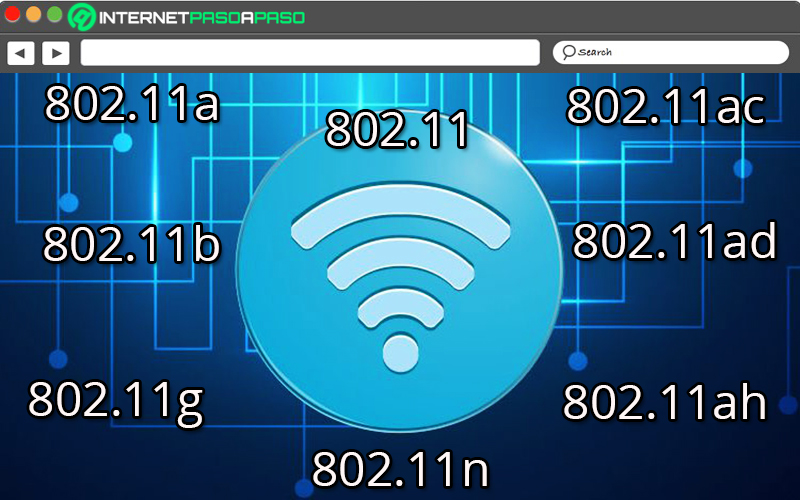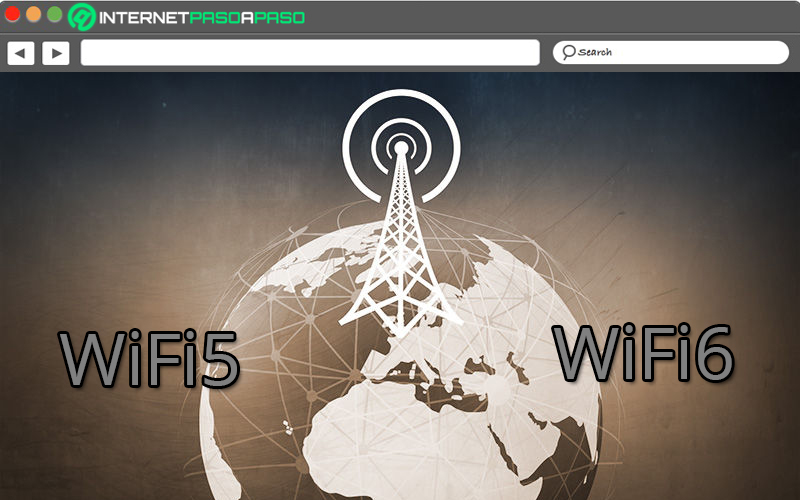
Index:
UPDATED ✅ Do you want to know once and for all, the versions of wireless connections? ⭐ ENTER HERE ⭐ and learn which is the best and fastest
Today, the Internet is a fundamental element in the daily life of human beings. As, virtually all activities have been coupled to the virtual world and therefore currently having a good internet connection in homes is essential.
However, beyond Internet connections based on wired networks, Wi-Fi has become the main wireless data transmission technology. In particular, because it shows the ability to reach the most remote and complex areas, where unable to establish a wired connection.
Therefore, it is valuable to know the most relevant details of this type of connection and, above all, discern how it works. In addition to that, it is also worth knowing what are all the frequencies and standards of wireless networks that exist and how they can influence your connection to the network. Which, we will explain below.
How does a WiFi network work to share a wireless signal?
Basically, a WiFi network works through radio waves, just as television and mobile telephony do. That is, transmit data over the air by a type of electromagnetic radiation with wavelengths in the electronic spectrum longer than the same infrared light. Now, in such a way, the wireless adapter card of a certain equipment transforms the data into radio signals that are directed from an antenna.
After that, the router or router receives these binary code signals and decodes them then send the information to Internet via LAN or wired Ethernet. It should be noted that, thanks to the fact that a WiFi connection it is bidirectionalThis process also works in reverse.
Which means that the wired Ethernet device transmits the information to a wireless router and said router is responsible for translating the signals to be able to send them to the computer’s adapter card. For its part, the radio waves used by a WiFi network, They usually operate on frequencies and this means that it is a wireless data transmission technology that It is based on different types of frequency that allow more or less data to be delivered, depending on its nature..
So, generally, the Wifi uses frequencies of 2.4GHz or 5.8GHZ and, apart from that, they have a specific standard that is in charge of determine the quality of connectivity and its performance. Considering that, all start from the initial 802.11 standard.
How does the standard of my WiFi network influence the quality of my Internet connection?

Although it is true, at present, there are different standards that have been implemented over time, in order to optimize the connectivity of a WiFi network and increase its performance. Reason why, it is a parameter that is meant to improve quality of service at the data link layer level.
Therefore, regarding its influence, we emphasize that, the more modern the standard used by the WiFi network, the greater bandwidth will have and thus, will show an optimal speed. On the contrary, if an older standard is used, the speeds obtained to navigate they will be minor and, therefore, the operation of the WiFi connection will be truncated by great slowness.
This means that, for example, if the first standard It will only allow speeds between 30Mpbs and 50 Mbpsthe latest wireless network standards may overcome the barrier of 500 Mbps and up to 1Gpbs. Thus revealing an amazing speed when surfing the net.
List of all the frequencies and standards of wireless networks that exist

Now, to know in more detail the operation of a WiFi wireless network through its standards and types of frequency, we proceed to specify What are they and what does each of these standards consist of? and, in addition to that, we will point out the frequencies that they use.
Go for it:
802.11 standard
It was introduced during the year 1997 and refers to the first transmission standard with WiFi technology which is named, specifically, “IEEE 802.11”. Which establishes the lower levels of the OSI model for wireless connections that use electromagnetic waves. A) Yes, in theory, it accepted up to 2 Mbit/s maximum speed and in practice, it only provided a total of 1 Mbit/s.
Therefore, it is a standard that revealed a speed of navigation very slow for most applications. However, at the time, was completely solid to work on what would be one of the best standards in the industry. On the other hand, it should be noted that brings together a family made up of: IEEE 802.1 for LAN connections, IEEE 802.3 for Ethernet connections over LAN, IEEE 802.11 for wireless connections over WiFi, and IEEE 802.15 for Bluetooth connections.
802.11a standard
Also It’s called “WiFi 5” and is characterized, mainly, by using radio signals of 5GHz, taking into account that it provides eight radio channels in the band of this frequency. In addition to this, it admits a greater bandwidth than the previous one, thanks to the fact that provides a maximum total throughput of 54 Mbps that, in practice, is about 30Mbps.
On the other hand, it is worth distinguishing that, East type of standard was developed at the same time as 802.11b and, although the latter was less popular at first, it took on a greater boom in homes thanks to the fact that offered greater range than 802.11a.
802.11b standard
As we mentioned before, it is a standard that was created at the same time as 802.11a. Regarding its main peculiarities, we highlight that, compared to the original standard that only provided speeds of 2 Mbit/s, this has the capacity to reach up to 11 Mbit/s in theory and 6 Mbit/s in practice. Also, uses the 2.4 GHz frequency with three available radio channels.
Thus, its scope is greater than the previous one and, therefore, offers coverage of up to 300 meters in an open space. However, its introduction was not without problems, since the 2.4 GHz frequency was not regulated and, unfortunately, it was causing interference.
802.11g standard
It is a standard that combines the best of 802.11a and 802.11b, since, reaches a speed of up to 54 Mbit/s and uses the 2.4 GHz frequency. Therefore, it provides optimal coverage of up to 460 meters. Additionally, It has the advantage of being compatible with 802.11b and so new 802.11g-based devices can connect to routers or access points that broadcast 802.11b. It should be noted that, was introduced in 2003.
802.11n standard
As of 2009, this modern wireless network standard was known, which led to one of the most important changes. Because, marked a turning point in technology by inducing MIMO networks. Which are characterized by using several antennas in the same router to send and receive data simultaneously.
Consequently, it is a standard that manages to significantly speed up the speed of the connection, since offers a theoretical speed of 600 Mbit/s and a practical speed of 100 Mbit/s. Apart from this, through 802.11n, it was possible to optimize coverage, reaching 300 meters outdoors and 120 meters indoors. even works with both 2.4 GHz and 5.4 GHz frequencies.
802.11ac standard
It is the most used standard in current routers, which was implemented in 2014 and It is characterized by using components that consume less energy. Also, uses beamforming technology, which focuses radio signals so that they reach further and can pass through walls. Therefore, although it uses the 5.4 GHz band and its coverage radius is smaller, its range at greater distances is completely optimal.
Additional to that, It provides a theoretical speed of 6.93 Gbps and its practical speed reaches 100 Mbit/s. However, it can be much faster because it uses wider radio channels and uses up to four antennasthus surpassing the nature of current routers that transfer six data streams at the same time just using three antennas.
802.11ad standard
After 802.11ac, a new standard was implemented that adopted the name “802.11ad”. This is little used today, since it offers a shorter range compared to its predecessor and, therefore, is also little known in the industry.
Nevertheless, achieves theoretical speeds of 7.13 Gbit/s and practical speeds of up to 6 Gbit/s. Which, although it may seem contradictory with respect to its minimum use, is because users still do not require speeds higher than those provided by the 802.11ac standard. In addition to that, it is also characterized by operating in 60 GHz bands and offers a range no greater than 300 meters.
802.11ah standard
Also Known As “IEEE 802.11ah” or “Wi-Fi HaLow”consists of a new wireless network protocol that began to be implemented as of 2016. Which, provides a range of up to 1,000 meters and has a bandwidth of 2 MHz.
Thus, basically, it is a standard that arises from the constant requirements of technology, the market and information. So, unlike the other types, it uses frequencies less than 1 GHz and thus, it manages to increase the range of reach. Thanks to this, it is a great solution for distribution in rural areas by simply using cell towers with sensors to share the signal. It should be noted that, apart from everything, is a protocol that competes with the popular Bluetooth.
On the other hand, in order to summarize all the information presented above, it is necessary to reveal the most interesting data of each of the WiFi network standards from an explanatory table such as the one presented below:
|
STANDARD TYPE |
FREQUENCY |
THEORETICAL SPEED |
PRACTICAL SPEED |
BANDWIDTH |
SCOPE |
|
802.11 |
2.4GHz | 2Mbit/s | 1Mbit/s | 22MHz | 330 meters |
|
802.11a |
5.4GHz | 54Mbit/s | 22Mbit/s | 20MHz | 390 meters |
|
802.11b |
2.4GHz | 11Mbit/s | 6Mbit/s | 22MHz | 460 meters |
|
802.11g |
2.4GHz | 54Mbit/s | 22Mbit/s | 20MHz | 460 meters |
|
802.11n |
2.4GHz and 5.4GHz | 600Mbit/s | 100Mbit/s | 20/40MHz | 820 meters |
|
802.11ac |
5.4GHz | 6.93Gbps | 1300Mbps | From 80 to 160MHz | It is a standard without interference but with less scope, although there are technologies that extend it |
|
802.11ad |
60GHz | 7.13Gbit/s | 6Gbit/s | 2MHz | 300 meters |
|
802.11ah |
0.9GHz | 35.6 Mbps on a channel with 8 MHz bandwidth | 26.7 Mbps on 6 and 7 MHz bandwidth channels | 2MHz | 1 km |
What is the most powerful wireless network with the best connection speed?

Now, after all, surely you’re wondering What is the most powerful wireless network standard with the best connection speed that exists?, Until now. Since, although many of them reveal excellent performance, not all are truly optimal to have an excellent Internet connection at any time.
In this sense, we can conclude that, around the standards and frequencies mentioned above, the most effective wireless network is 802.11a or, failing that, WiFi 5. Since it employs a frequency range of 5.2 to 5.8GHzreaches speeds of up to 54Mbit/s and allows the use of multiple channels in order to avoid interference between the access point.
But, there is also another standard that reveals a great quality and connection speed, which is why it has given much to talk about today. East, It is known as “WiFi 6” or “802.11ax” and emerged during the year 2018. Thus, it is a wireless transmission protocol focused on improve the speed of an Internet connection and optimize its stability by having many devices connected.
On the other hand, it is also characterized by offer remarkable energy efficiencycompared to the other versions. In addition to this, consists of a standard compatible and, therefore, any device with connectivity WiFi 6 You can connect to networks under an older version, as long as the router and device support this protocol.
In short, today, the most powerful wireless networks with better quality in terms of connection speed, They are WiFi5 and WiFi6. Taking into account that the latter increases the theoretical 6.9 Gbps of WiFi 5 to 9.6 Gbps; so, the 802.11ax standard it is 40% faster and, in addition, its latency is only reduced by around 75%.
networks